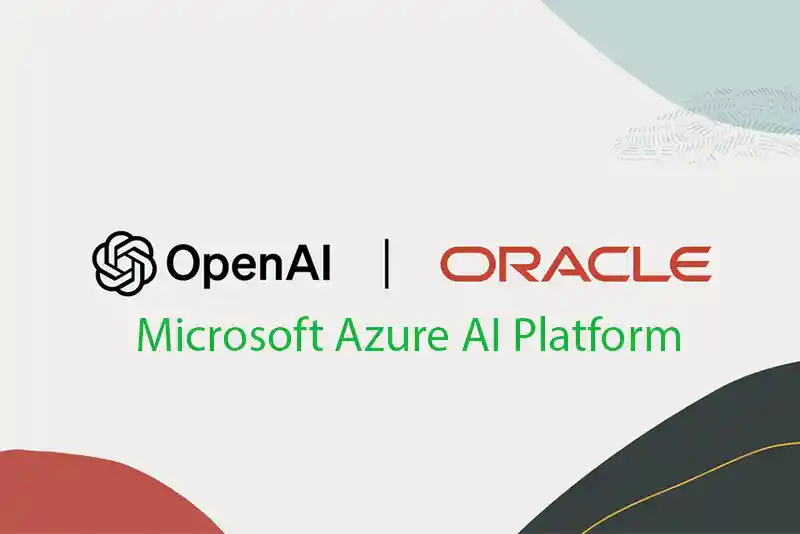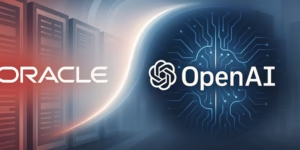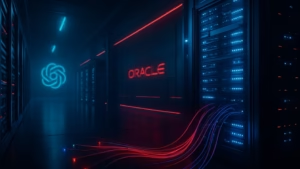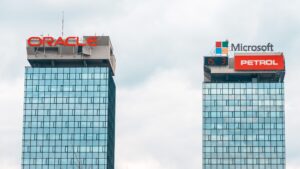Oracle and OpenAI: Inside a Partnership That’s Reshaping AI Infrastructure
The partnership between Oracle and OpenAI has gone from a cautious infrastructure collaboration to one of the most consequential ties in the cloud and AI era — a relationship that now spans capacity-sharing, joint data-center development, and, according to multiple reports, a multibillion-(even multihundred-billion) dollar commercial commitment. What started as an effort to provide additional compute capacity for OpenAI’s rapidly growing workloads has matured into a strategic axis that raises questions about competition, national AI strategy, vendor lock-in, and how frontier models will be hosted and governed. Below I unpack the history, commercial mechanics, technical implications, business incentives, and what this partnership could mean for customers, competitors, and regulators. Oracle+2OpenAI+2
A short timeline: from capacity-sharing to Stargate and beyond
The relationship accelerated publicly in 2024 when Oracle, Microsoft, and OpenAI announced an arrangement to extend Microsoft’s Azure AI platform onto Oracle Cloud Infrastructure (OCI) to provide OpenAI with additional capacity. That announcement signaled a pragmatic approach: instead of a single hyperscaler supplying all compute needs, OpenAI would diversify suppliers and tap OCI for scale and geographic reach. Oracle
In early 2025 OpenAI introduced “Project Stargate,” a large-scale ambition to build tens of gigawatts of AI-grade data center capacity with a set of partners that included Arm, Microsoft, NVIDIA and Oracle. Stargate positioned Oracle not just as a cloud vendor but as an active participant in a broader infrastructure program to anchor U.S. AI leadership and industrial-scale compute. OpenAI
In mid-2025 the partners announced plans to jointly develop additional Stargate capacity — notably a 4.5-gigawatt data-center commitment in the U.S. — with Oracle playing a major role in buildout and operations. Then, in September 2025, multiple outlets reported that OpenAI inked a multi-year purchase commitment for Oracle compute capacity — reports put the headline figure at roughly $300 billion over about five years beginning in 2027. Those reports, if accurate, represent one of the largest cloud commitments in history and crystallize the commercial seriousness of the tie. Campus Technology+1
Why Oracle? What OpenAI gains
There are several concrete reasons Oracle became a strong option for OpenAI:
-
Raw capacity and data center scale — OpenAI’s training and inference loads demand enormous power and rack density. Oracle’s investments in OCI and willingness to back large buildouts through Stargate give OpenAI another reliable channel to deploy compute at scale. Campus Technology
-
Geographic and supplier diversification — Relying exclusively on a single cloud provider exposes a company to supply-side constraints, geopolitical risk, and commercial leverage. By running workloads across multiple cloud partners (Azure, OCI, and others inside Stargate), OpenAI reduces single-vendor concentration risk.
-
Enterprise market reach — Oracle brings deep relationships with enterprise customers across ERP, finance, healthcare, and government verticals. That can help OpenAI integrate model capabilities into business-critical systems and sell enterprise-grade solutions that combine Oracle’s data with OpenAI models. Oracle
-
Financial and contractual terms tied to long-term capacity — A multi-year commitment to buy capacity creates predictability for both parties. For Oracle it’s a nearly unprecedented revenue pipeline; for OpenAI it secures future capacity planning. Reported headline figures emphasize the scale and long horizon of that predictability. Wall Street Journal+1
Why Oracle benefits
For Oracle, the partnership is transformational in multiple ways:
-
Credibility in AI infrastructure. Historically perceived as a smaller cloud competitor versus AWS, Azure, and Google Cloud, landing a marquee AI customer like OpenAI — particularly under a large, multi-year agreement — signals OCI as a serious place to run frontier workloads. Reuters and other outlets reported major stock and valuation moves for Oracle tied to these deals. Reuters
-
Upsell into enterprise stacks. Embedding OpenAI models (and later iterations) across Oracle’s database and SaaS portfolio—already underway in some product announcements—creates upsell pathways and differentiates Oracle’s cloud marketplace. Oracle has signaled integration work that places model capabilities inside Oracle Database and Fusion applications. Oracle
-
Strategic positioning vs. hyperscalers. By participating in Stargate and taking on significant infrastructure volumes for generative-AI workloads, Oracle moves from a niche cloud alternative to a central actor in the geopolitical and commercial race for AI infrastructure.
Technical architecture — how the pieces fit
While full technical blueprints are proprietary, public clues and industry patterns let us sketch the high-level architecture:
-
Training farms at scale. OpenAI will place large GPU/accelerator clusters in OCI-operated and jointly built Stargate campuses. These clusters will be optimized for high-density power, liquid cooling, and dedicated networking to minimize latency between machines during large-model training. OpenAI
-
Interconnects and co-location. To achieve acceptable throughput for training and fine-tuning, OpenAI will likely co-locate storage, parameter servers, and high-speed interconnects (NVLink, InfiniBand) within the same datacenter campuses or nearby availability zones.
-
Hybrid hosting for inference. For inference at global scale, OpenAI may distribute workloads across Azure, OCI, and edge locations to optimize cost, latency, and regulatory needs — for instance, keeping customer data and inference inside specific cloud regions for compliance.
-
Custom chips and partnerships. OpenAI has also pursued custom silicon partnerships (reported collaborations with Broadcom and close work with NVIDIA). A multi-cloud approach helps combine different accelerator ecosystems and negotiate custom hardware footprints inside partner campuses. OpenAI
Competition, lock-in and strategic risk
A partnership of this size invites scrutiny and competing-alignment questions.
-
Vendor lock-in concerns. A huge multi-year purchase commitment can create de-facto vendor lock-in. Even if OpenAI intends to remain multi-cloud, the economics and specialized deployments tied to Oracle’s Stargate campuses could make migration costly. That’s a double-edged sword: predictability for both parties, but reduced flexibility if needs change.
-
Hyperscaler reactions. Microsoft (OpenAI’s long-standing partner) and other cloud providers might respond by increasing investment, lowering prices, or offering differentiated services (deeper integration with Windows/Office stacks, exclusive enterprise packages) to retain share. The cloud market increasingly looks like a space of strategic exclusives rather than pure commodity compute.
-
Regulatory and national security lens. Large AI infrastructure deals attract attention from regulators concerned with competition, national resilience, and concentration of strategic resources. Any cross-company control over critical compute capacity (especially in energy-intensive builds) will draw government interest. The Stargate project explicitly framed part of its rationale as advancing U.S. AI leadership, which brings both support and close regulatory visibility. OpenAI
Commercial and market implications
The reported scale of the compute purchase is staggering and has ripple effects:
-
Oracle’s financial profile. Large signings contribute to future revenue commitments and boost investor confidence. Reuters reported a major market reaction tied to these deals that materially altered Oracle’s market cap and investor narrative. Reuters
-
Customer product roadmaps. If Oracle embeds OpenAI models into its database and SaaS products, enterprise customers will receive tighter, more native AI features (e.g., automated workflows, human-like query assistants over business data). Oracle’s August 2025 announcement about deploying an advanced OpenAI model across its portfolio is an example of this trajectory. Oracle
-
Price and capacity dynamics. A committed major buyer can alter the economics of cloud infrastructure: predictable long-term demand can justify more aggressive capital spending on data centers, but also alter pricing leverage for other customers. Smaller cloud customers might benefit from increased capacity, but competition for spot resources during peaks could become fiercer.
Governance, ethics, and operational transparency
Big infrastructure deals raise questions beyond money and machines:
-
Data stewardship. Enterprises and governments will ask how data is handled across joint infrastructures, what safeguards exist, and how model training is audited — especially when models are fine-tuned on or used with sensitive enterprise data.
-
Model accountability and safety. As models scale in capability, governance mechanisms — red teaming, model cards, access controls, and safety layers — must be embedded across deployment partners. Multi-cloud and multi-partner architectures complicate responsibility matrices.
-
Energy and sustainability. Building gigawatts of data center power consumption has environmental and local community impacts. Stargate and its partners will face scrutiny on energy sourcing, water use, and local grid impacts as builds accelerate. OpenAI
What this means for competitors and customers
-
For Microsoft & AWS & Google. Expect intensified offers, deeper enterprise integrations, or alternative multi-cloud packages. The cloud market is now as much political and strategic as it is technical.
-
For enterprise customers. More choices for where to run generative AI workloads — and more bundled options: run OpenAI models natively inside Oracle apps, or purchase managed OpenAI services on Azure/OCI combinations. Customers need to evaluate governance, latency, cost, and data residency tradeoffs.
-
For startups and system integrators. Large deals can compress talent markets (more demand for data-center engineering, MLOps, and security) while also opening opportunities to build tools that bridge multi-cloud AI deployments (data pipelines, orchestration layers, cost optimizers).
Risks and open questions
There are still many unknowns. Journalistic reports about massive multi-year deals are often accurate on intent but can obscure contract mechanics. Key questions remain:
-
Are the reported figures headline commitments, purchase options, or notional ceilings? Public reporting sometimes conflates purchase commitments with total addressable value. (News outlets cite a $300B figure; definitive contract terms remain private.) Wall Street Journal+1
-
How will OpenAI balance partnerships across Oracle and Microsoft without fracturing engineering efficiency or licensing complexity?
-
What operational controls and auditing mechanisms will be standardized across the Stargate campuses to ensure safety and compliance?
Bottom line — a strategic inflection point
Oracle and OpenAI’s partnership marks a strategic inflection point in how frontier AI will be hosted and commercialized. For Oracle, it’s a leap into prime positioning for AI infrastructure and enterprise AI. For OpenAI, it’s a bet on diversified, scalable capacity and the ability to deploy models where enterprise customers and national policy priorities demand them. For the broader market, the deal redefines questions about vendor concentration, national strategy for AI compute, and how enterprise software vendors will bundle intelligence into the services customers rely on.
As with any fast-moving area, facts will keep evolving — contract details, regulatory responses, and technical implementations will unfold over the coming quarters. But the core takeaway is already clear: infrastructure partnerships like Oracle-OpenAI are where the economics and geopolitics of the next generation of AI will be decided. Campus Technology+2OpenAI+2
Sources & further reading (selection of recent reporting and official statements): Reuters reporting on the deal and market reaction; Wall Street Journal coverage of the contract; Oracle and OpenAI press pages describing the Stargate program and product integrations; and Oracle’s product announcements showing deeper deployments of OpenAI models across its offerings. Oracle+3Reuters+3Wall Street Journal+3
For quick updates, follow our whatsapp channel – https://whatsapp.com/channel/0029VbAabEC11ulGy0ZwRi3j
https://bitsofall.com/https-yourblog-com-microsoft-planned-shift-to-anthropics-ai/
Arm’s new mobile chips: Lumex, Mali G1-Ultra, and the push to put AI on your phone







